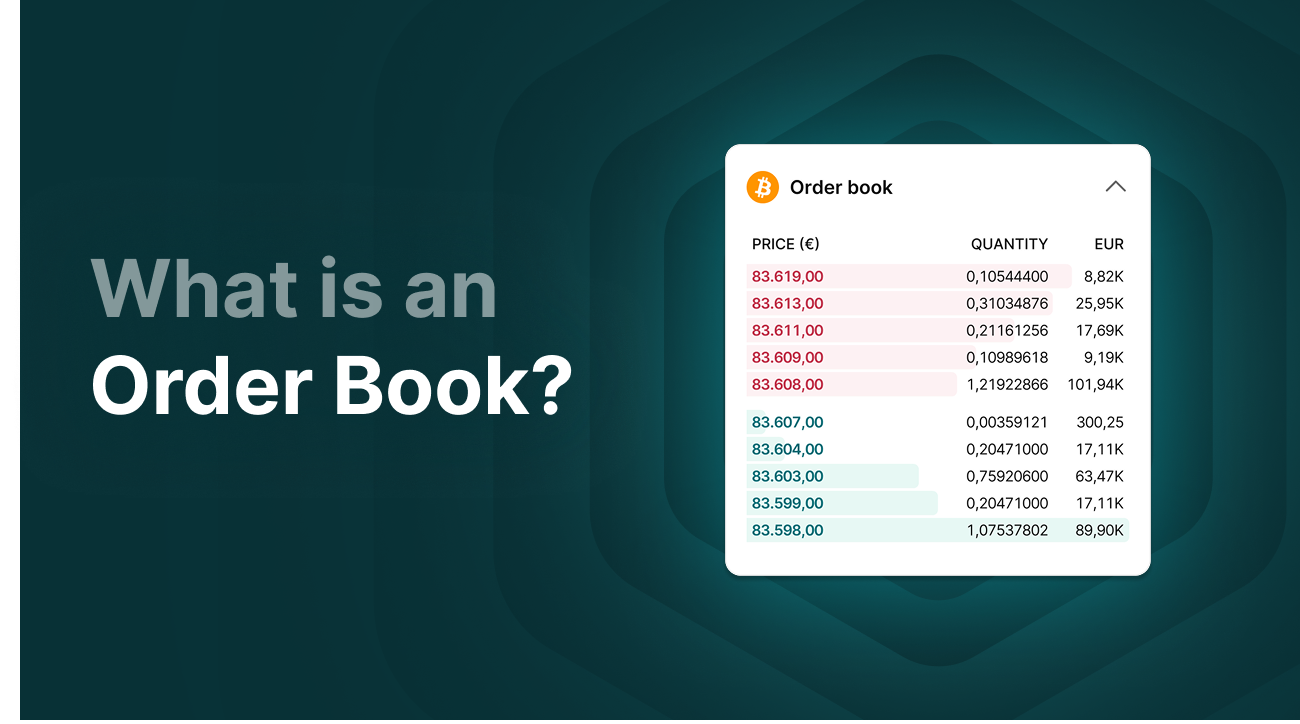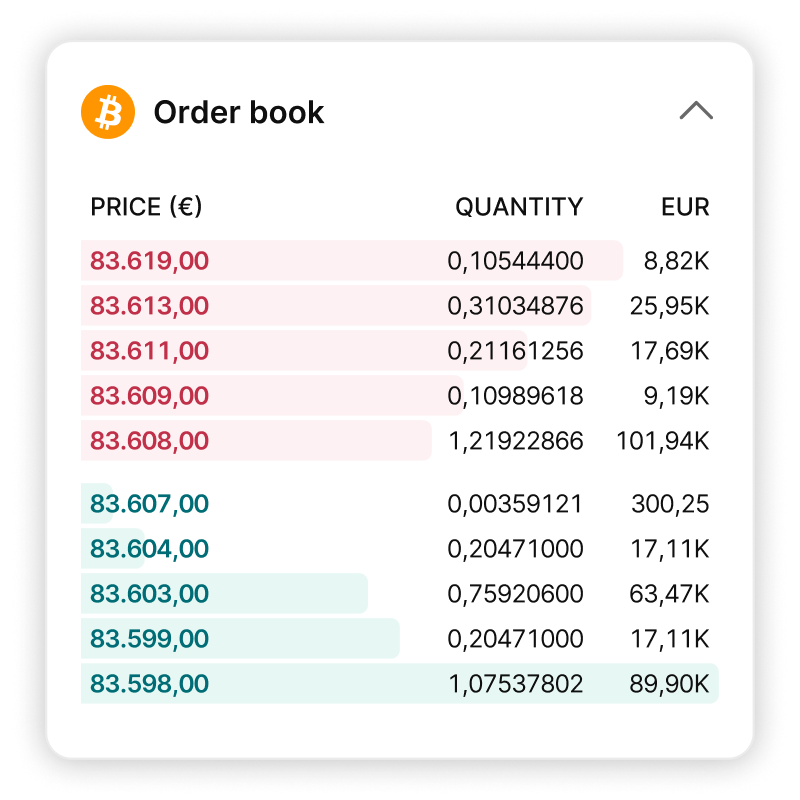What Is an Order Book and How Does It Work?

What Is an Order Book?
An order book is a real-time digital record of all open buy and sell orders on the market for a specific asset, such as a cryptocurrency, stock and ETF. Traders use the order book as a tool on trading platforms, such as crypto platforms and stock exchanges.
In the order book, supply and demand are brought together by an intermediary, typically the exchange or broker, such as Finst. Essentially, the order book lets you see whether there is demand and supply for a specific asset and at what prices traders are willing to buy or sell assets like Bitcoin and Ethereum.
Key takeaways:
- An order book is a digital record of all open buy and sell orders for a specific asset, such as a cryptocurrency or stock.
- It brings supply and demand together via an exchange or broker and shows the prices at which traders are willing to buy or sell.
- Bid (buy) and ask (sell) orders are clearly displayed, including price levels and available quantities.
- Market depth gives insight into where strong buying or selling pressure lies and can help predict price movements.
- An order book helps traders better understand supply, demand, liquidity, and potential price movements.

How Does an Order Book Work?
An order book is a real-time record of all open orders for a specific asset, like Bitcoin, gathering both Bid Orders (buy orders) and Ask Orders (sell orders). On the Bid side (typically shown in green), you can see the prices buyers are willing to pay, along with the number of buy orders at each price level. It also shows the overall quantity of the asset being requested by buyers. On the opposite side, the Ask Orders (often shown in red) display how much of the asset is being offered for sale at each price level.
In short, an order book visualizes market depth. Traders can gain insight into which price levels are likely to see large volumes, helping them make informed trading decisions.
Quick summary of key terms:
- Buy Orders (Bids) – The highest prices buyers are willing to pay for an asset.
- Sell Orders (Asks) – The lowest prices sellers are willing to accept for their asset.
- Market Depth – Based on the quantity available at each price level, traders can gauge where strong buying or selling pressure exists. This could signal potential price movements.
How Market Depth Provides Insight Into a Cryptocurrency’s Liquidity
The market depth of an order book indicates the liquidity of a cryptocurrency on a trading platform. When there are many open buy and sell orders, it indicates high liquidity, making it easier for traders to buy or sell a specific cryptocurrency. If that's not the case, you may need to buy or sell your crypto in phases or struggle to trade at all. This situation describes an illiquid market.
Low liquidity can lead to higher slippage, meaning the actual execution price differs from the desired price level. Slippage often occurs when the market moves rapidly or when there aren’t enough buyers or sellers available.
Market depth is visualized through the so-called "depth chart," which we discuss further under the Volume Order Book section.
Types of Order Books
There are different types of order books, each serving a slightly different purpose. The most common types are the Volume Order Book, Price Order Book, and Aggregated Order Book. Here’s a breakdown:
Price Order Book
The Price Order Book is the most common form found on exchanges. It shows the exact price levels at which a specific asset is offered (red sell orders) and the prices buyers are willing to pay (green buy orders). On trading platforms, these are listed for a specific trading pair, like ETH/USDC, labeled as bids (buy orders) and asks (sell orders).
Volume Order Book
The Volume Order Book highlights market depth and complements the Price Order Book. On trading platforms, this is often shown as the "depth chart." It visualizes the cumulative volume of buy and sell orders at different price levels, making it easier to see how much demand and supply exist.
Sometimes large buy or sell orders create a "wall" in the order book. A buy wall (green wall) is a large concentration of buy orders at a certain price level, while a sell wall (red wall) shows many sell orders at a certain price.
Traders often use the depth chart to assess whether buying or selling pressure dominates, which can help predict potential price movements. A higher concentration of buy orders at a lower price can indicate support, while a sell wall near a specific price can act as resistance.
Aggregated Order Book
An Aggregated Order Book is commonly found in the DeFi sector. dApps (decentralized apps) like 1Inch and Jito offer aggregated order books. These combine supply and demand from multiple platforms, which is particularly useful for traders looking to see the popularity of a crypto across platforms — and to find the best available price with minimal fees.
Some centralized platforms also use an aggregated order book structure, including Finst. On Finst's order book, orders from multiple trading venues are aggregated to offer traders better liquidity and more competitive prices.
Working With an Order Book
Within the trading landscape, different order types can help you strategically respond to opportunities identified in the order book:
Limit Orders
A limit order lets you specify the price at which you want to buy or sell crypto. On most exchanges, once you place a limit order, it will appear in the order book, where it can be seen by other traders. A limit buy order shows up among the bids, while a limit sell order appears among the asks.
Stop Loss Orders
As a crypto trader, you can set a stop loss order to protect your capital against sharp drops. If the price falls below a specified level, a market order is automatically triggered. Unlike a limit order, a stop loss order only appears in the order book on most exchanges once the price threshold is reached.
Market Orders
A market order buys crypto at the best available ask price or sells at the best bid price. While market orders execute quickly, you risk paying more (when buying) or receiving less (when selling) than intended, especially with large quantities. If the amount you want to trade exceeds what’s available at the current price, the system fills your order across multiple prices.
Iceberg Orders
An iceberg order is a large buy or sell order broken into smaller chunks to conceal its true size. Professional traders use iceberg orders to avoid alarming the market or giving away their strategy.
Example: A trader wants to sell 1,000 ETH but only displays 50 ETH at a time. Once the 50 ETH are sold, the next 50 ETH are revealed, and so on.
Just like a real iceberg, most of the order remains hidden beneath the surface.
Trailing Stop Orders
A trailing stop order is a dynamic stop loss that automatically adjusts as the asset’s price rises. It’s a smart way to lock in profits while still protecting against a reversal. Once triggered, the platform executes your order automatically.
Example: You set a trailing stop at €80,000 per BTC. If the price rises to €82,000, the stop moves up to €81,000. If the price then falls below €81,000, your order gets executed.
Like a regular stop loss, a trailing stop only becomes visible in the order book once triggered.
What Are Market Makers?
While researching trading, you may come across the term market makers (also called liquidity providers). They are usually companies or groups of professional trading firms that provide liquidity for specific trading pairs by constantly placing new buy (bid) and sell (ask) orders in the order book. Thanks to market makers, traders can execute their trades more easily without waiting for natural buyers or sellers.
Market makers typically earn money from the spread, which is the difference between the highest buying price and the lowest selling price.
Why Are Market Makers Important for Order Books?
- Provide liquidity: They keep the order book filled with active buy and sell orders, ensuring there’s always someone to match your trade.
- Tighten spreads: More active market makers result in smaller differences between buying and selling prices, making trading cheaper.
- Stabilize prices: Their constant activity reduces the chances of extreme price swings.
- Faster order execution: Thanks to their presence, trades are filled more quickly.
Why Crypto Traders Use Order Books in Their Trading Strategies
An order book might look complicated at first, but especially for day traders trying to capitalize on short-term price movements, it’s a vital tool. It provides insight into a cryptocurrency’s volatility, demand, and supply, which can help traders determine the best time to enter or exit a position.
For swing traders (those who hold positions for a few days or weeks), combining candle charts and order book data can be very useful. Candle charts (or candlestick charts) are advanced graphs showing the price movement of a trading pair over a set timeframe. Depending on the setting (e.g., every 5 minutes or every hour), a new candle is generated. Each candle displays the open, high, low, and close prices. A green candle indicates a higher closing price than the previous candle; a red candle indicates a lower close.
By combining candlestick charts with volume order book data, traders can spot potential support or resistance levels through "walls" and better anticipate market direction.
Conclusion
An order book is a powerful tool for understanding supply and demand dynamics in the crypto market. It offers transparency regarding price levels and trading volumes. This can help you make smart trading decisions. Whether you’re a day trader seeking the perfect entry point or a long-term investor waiting for the right price, the order book helps you grasp market dynamics and apply your trading strategies effectively and transparently.
Disclaimer: The information provided in this article is for informational purposes only and should not be considered financial advice. Always do your own research before making investment decisions.
